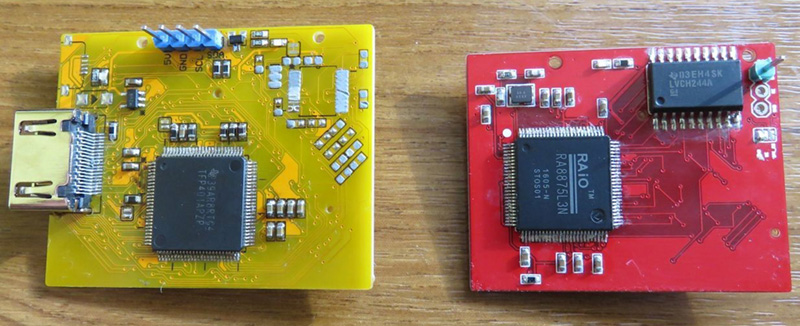LCDs come in a lot of sizes, and there’s a lot written about pushing pixel data out to larger displays. Smaller LCDs, like the 4, 5 and 7 inch variety, aren’t used much, because no one seems to know how to drive the things. For [Joe]’s Hackaday Prize Entry, he’s creating an open source interface for tiny LCDs, making it easy and cheap to add one to everything with an HDMI port.
[Joe]’s Open LCD Interface comes on two boards, with the first providing connections to an LCD, all the power circuitry required, and a bunch of pads to break out every IO line. The second part of the puzzle is a decoder that takes HDMI signals and drives a small LCD.
HDMI decoders are nothing new to the world of hobby electronics – there are multiple projects that give the BeagleBoard a display through HDMI. Even Adafruit sells one of these converters. [Joe]’s board has another trick up its sleeve, though: it can give any microcontroller a high-resolution display, too.
There’s another module that connects to [Joe]’s breakout board that turns the LCD into an SPI display. This means any microcontroller can drive a high-resolution display. It’s fast, too: in the video below, [Joe]’s SPI display can push pixels at least as fast as any other microcontroller-based display we’ve seen.
It’s a great project, and a by opening up the doors to millions of cheap LCDs on eBay and Alibaba, [Joe] has a great entry for the Hackaday Prize on his hands.




















2 holes ..1 for my big dog..1 for my small dog …
Simply fantastic. I want one!
It’s not clear to me what the three separate boards are needed for. It looks like there’s a board that supplies power and connections to the LCD and to GPIO or SPI, and then a daughterboard that either passes through the GPIO or SPI signals to an LCD driver chip, or connects to HDMI through a different driver chip. Since the power supply seems like a minor expense, wouldn’t it be simpler to make one board that provides everything for an SPI- or GPIO-based LCD display, and a separate one that does the same for HDMI?
Im also cunfused
especially considering Pee has a proper parallel 888 RGB output port, all you need is rgb-lvds chip like hmm google feeling lucky DS90CF384A
yes yes yes … make this with some FHD 5″ bundle and I’m all sold
Aliexpess is full of various boards for <$20 based on the RTD2660 chip… they come in LVDS or TTL (or even both at the same time) and can have: an HDMI port, 2 composite inputs, D-SUB and/or DVI-D…capable of driving full-HD and even more (with adequate power and heatsinking)…has a scaler, which the chip in the hack lacks…
The one problem that plagues these awesome things is the lack of cheap and user-friendly way of programming them…
Some of them can be programmed using a common USB to RS232 adapter.
A few interesting links on the subject.
http://tech.mattmillman.com/lcd/rovatools/ftdi-ft232h/
https://sites.google.com/site/lcd4hobby/home
http://www.elecrealm.com/down/class/
I’m sure there are boards on AliEx .. but would any of them work with screens like 5″ fhd display replacement for LG G2 .. which you could get like for 35 USD ? i don’t think so .. at least i have not found an easy and affordable “small” fhd solution yet
Mobile phone screens use MIPI which is PITA at high resolutions. There is this project: http://hackaday.com/2014/08/19/a-mipi-dsi-display-shieldhdmi-adapter
It should be good for an iPhone screen, but FHD may be beyond it’s capabilities unless you are willing to use 16 bit/pixel.
well, there is this http://www.codeforge.com/article/258602
and this https://github.com/ghent360/RTD-2660-Programmer/
aaand this http://openrtd2662.ru/
did I mention this http://s.pudn.com/search_hot_en.asp?k=rtd2660 ?
so yeah, plenty of firmware source code floating around :)
hope mods let post with all those links thru
Thanks, I wrote the RTD2600 programmer code. There is a very cheap board called PCB800099, if you want to write a custom firmware for it you may find this useful:
The hardware on the PCB800099 is connected like follows:
Keyboard is a scale or resistors connected to ADC3.
The panel power control is on pin P3^3
Backlight power is P3^4
Green LED P1^1
Red LEG P6^2
VGA is connected to video port A0
HDMI is connected to video port D0
AV1 is connected to video port V1
AV2 is connected to video port V2
There is no i2c eeprom on the board all settings are stored in the SPI flash.
There is no audio on the board.
Does HDCP come into play here at all?
WHy would it? You aren’t going to connect it to a damn sony bluray player or are you?
Why does it matter to you? Maybe all evad has is a blue ray player. Heaven forbid you’d want to watch HDCP content on this display….regardless of the source.
That being said, I doubt it does support HDCP…but it doesn’t hurt to ask.
I can see this working well for everything from a mini games console to a small touch screen wifi remote for a home automation system.
Take my money!